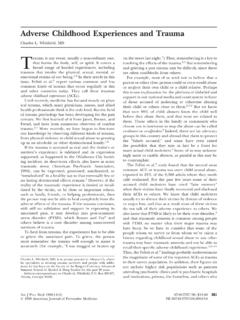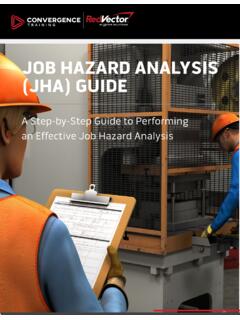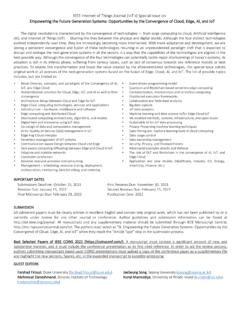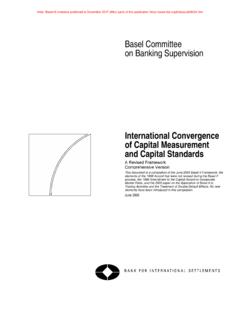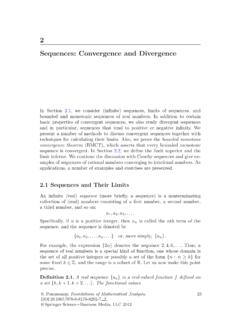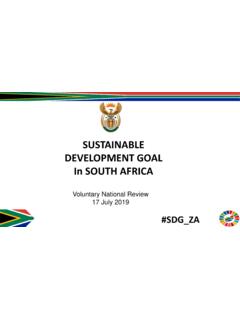Transcription of The Convergence of Neurobiology and Epidemiology
1 1 The Health and Social Impact of Growing Up With Adverse Childhood Experiences The Human and Economic Costs of the Status Quo Robert Anda, MD, MS Co-Principal Investigator Adverse Childhood Experiences (ACE) Study The common stressful and traumatic exposures affecting the (neuro)development of our children are referred to herein as adverse childhood experiences (ACEs). Key among the constellation of these experiences is growing up in households affected by alcohol abuse; others include abuse (emotional, physical, sexual), neglect (emotional, physical), witnessing domestic violence, and growing up with substance abusing, mentally ill, parental discord, or crime in the home The information presented in this handout is in the public domain (reference list)1-41 and does not necessarily reflect the viewpoints of any organization(s) with which Dr.
2 Anda may currently be, or has previously been affiliated. 2 Executive Summary The Adverse Childhood Experiences (ACE) Study is a decade-long and ongoing study designed to examine the childhood origins of many of our Nation s leading health and social problems. The Study represents collaboration between the Nation s leading prevention agency, the Centers for Disease Control and Prevention (CDC) and the Kaiser Health Plan s Department of Preventive Medicine in San Diego, The key concept underlying the Study is that stressful or traumatic childhood experiences such as abuse, neglect, witnessing domestic violence, or growing up with alcohol or other substance abuse, mental illness, parental discord, or crime in the home (which we termed adverse childhood experiences or ACEs) are a common pathway to social, emotional, and cognitive impairments that lead to increased risk of unhealthy behaviors, risk of violence or re-victimization, disease, disability and premature mortality (Figure A).
3 1-4,36,37 We now know from breakthroughs in Neurobiology that ACEs disrupt neurodevelopment and can have lasting effects on brain structure and function the biologic pathways that likely explain the strength of the findings from the ACE Figure Framework for the ACE Study Adoption of Health-risk BehaviorsSocial, Emotional, & Cognitive ImpairmentEarlyDeathAdverse Childhood ExperiencesDeathDisease, Disabilityand Social ProblemsConceptionScientificgaps We found that ACEs are common, even in a relatively well educated population of patients enrolled in one of the Nation s leading ,13,18,2336,37 More than 1 in 4 grew up with substance abuse and two-thirds had at least one ACE! More than 1 in 10 had 5 or more ACEs! And we found that ACEs are highly In order to assess the relationship of the ACEs to health and social problems we developed the ACE Score, which is a count of the number of ACEs designed to assess their cumulative impact on childhood development and therefore, their impact on a variety of health and social priorities in our country.
4 What we found, using the ACE Score, stunned us even more. As the ACE Score increases so does the risk of numerous health and social problems throughout the lifespan (See Figure below). These problems are a Who s Who? list of problems that encompass the priorities of many agencies, public and private, that are working to prevent and treat a vast array of A summary of the problems strongly associated with the ACE Score follows. 3 Adverse Childhood ExperiencesAs a National Health IssueACEs have a strong influence on:-adolescent health-teen pregnancy-smoking-alcohol abuse-illicit drug abuse-sexual behavior-mental health-risk of revictimization-stability of relationships-performance in the workforce ACEs increase the risk of:-Heart disease-Chronic Lung disease-Liver disease-Suicide-Injuries-HIV and STDs-and other risks for the leadingcauses of death This vast array of problems that arise from ACEs calls for an integrated, rather than a separate or categorical perspective of the origins of health and social problems throughout the lifespan.
5 This approach to growing up with ACEs, and to the consequences of exposure to them, may unify and improve our understanding of many seemingly unrelated health and social problems that tend to be identified and treated as categorically separate issues in Western society. Development of more integrated approaches will likely contribute to more meaningful diagnoses, improved treatment of affected persons, and better integration of research priorities, preventive and social services, and legal ,3 The ACE Study calls for an integrated approach to intervene early on children growing up being abused, neglected, witnessing domestic violence, or with substance abusing, mentally ill, or criminal household members. All of these childhood stressors are interrelated and usually co-occur in these homes. Prevention and treatment of one ACE frequently can mean that similar efforts are needed to treat multiple persons in affected families.
6 4 Introduction This overview focuses on key findings from the ACE Study, published in peer-reviewed scientific journals, with an emphasis on how growing up with alcohol abuse and/or illicit drug use in the home becomes part of a spectrum of damaging childhood experiences. These childhood traumas lead to a wide array of negative health and social consequences. The key concept behind the design of the ACE Study is that risk factors for health and social problems are not randomly distributed in the US population. We hypothesized that the experiences of childhood specifically stressful or traumatic experiences that can negatively affect childhood development were fundamental underpinnings of the occurrence of these problems. We sought to fill the scientific gaps using a whole life model as depicted in Figure 1, ,38 Figure 1-Conceptual Framework for the ACE Study. Adoption of Health-risk BehaviorsSocial, Emotional, & Cognitive ImpairmentEarlyDeathAdverse Childhood ExperiencesDeathDisease, Disabilityand Social ProblemsConceptionScientificgaps It is important to recognize that: Adverse childhood experiences (ACEs) are common.
7 ACEs tend to occur in clusters, rather than single experiences. The cumulative impact of multiple exposures can be captured in an ACE Score . The ACE score likely captures the cumulative (neuro)developmental consequences of traumatic stress. The ACE Score has a strong, graded relationship to numerous health, social, and behavioral problems throughout a person's lifespan These ACE-related problems tend to be co-morbid or co-occurring These points will be highlighted in the course of this review. 5 Design of the ACE Study The Adverse Childhood Experiences (ACE) Study is the largest of its kind ever conducted both in size and scope of information collected. It examines the health and social effects of adverse childhood experiences throughout the lifespan and is an ongoing, decade-long collaboration between the Division of Adult and Community Health at the Centers for Disease Control and Prevention (CDC) and Kaiser Permanente s Department of Preventive Medicine in San Diego.
8 The relationship of these experiences to a wide range of health and social problems throughout the lifespan has been, and continues to be, described by the ACE Study ,36,38 During two survey waves conducted during 1995 to 1997, 17,337 predominantly well educated, middle-class members of the Kaiser Permanente Medical Care Program in San Diego, California agreed to participate in the Study, as part of a comprehensive medical Prospective assessment of the relationships of ACEs to health care utilization, rates of pharmaceuticals prescribed, disease incidence, and causes of death is an ongoing focus of the Study (Figure 2). Figure 2. Design of the ACE Study Follow-upACE Study DesignSurvey Wave I--70% response Mortality(9,508/13,494)Natio n al Death In d exMorbidity Hospital DischargeOutpatient VisitsSurvey Wave II--65% response Emergency room (8,667/13,330) vi s i tsPharmacy UtilizationAll medical evaluationsabstracted from both waves(N = 17,421) The ACE study population included 9,367 (54%) women and 7,970 (46%) men (total sample=17,337).
9 Their mean age was 56 years. Seventy-five percent were white, 39% were college graduates, 36% had some college education, and 18% were high school graduates. Only 7% had not graduated from high ,13 The Study assessed 10 categories of stressful or traumatic childhood The experiences chosen for study were based upon prior research that has shown them to have significant adverse health or social implications, and for which efforts in the public and private sector exist to reduce the frequency and consequences of their occurrence. Prior research into the effects of childhood maltreatment and related experiences (including witnessing domestic violence) has tended to focus on only one or two categories of experience, such as physical or sexual abuse or domestic violence, and has generally focused on a limited range of outcomes. The ACE Study is unique not only because of its size, but because it was also designed to assess the relationships of a broad range of adverse childhood experiences (ACEs) to a wide range of health and social consequences.
10 6 The 10 ACEs studied are as follows: Childhood abuse -Emotional -Physical -Sexual Neglect -Emotional -Physical Growing up in a seriously dysfunctional household as evidenced by: -Witnessing domestic violence -Alcohol or other substance abuse in the home - Mentally ill or suicidal household members - Parental marital discord (as evidenced by separation or divorce) - Crime in the home (as evidenced by having a household member imprisoned) ACEs Are Common The first important conclusion to be drawn is that adverse childhood experiences are very common, even in this well-educated, predominantly middle-class study sample (Figure 3, below).

